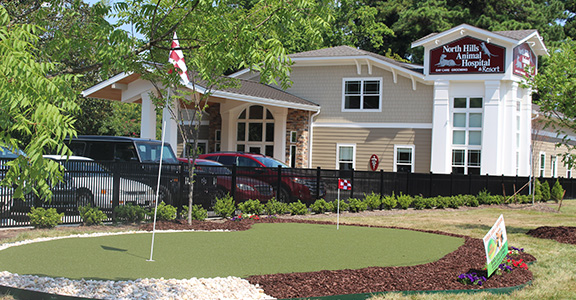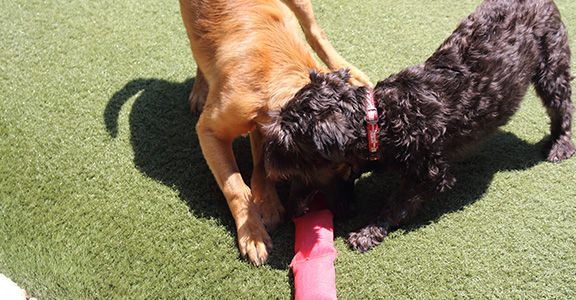
Spring is such a beautiful time of year in Raleigh. The sun rises earlier and conveys more warmth; flowers, grasses and new leaves replace the gray of winter; and birds burst into song. What’s not to like?
Well, pollen for one thing! And biting insects. And rising heat and humidity. Spring might be beautiful, but it does come at a cost. Here are a few ways that cost might be paid by your pet and how to alleviate your pet’s symptoms.

Seasonal Pet Allergies.
Our pets are not immune to the effects of springtime allergies. Pollen, dust mites, danders and mold spores are a common source of allergies for both people and pets. Unless you hermetically seal your house and pipe in air from the North Pole, these allergens are unavoidable where we live.
Pets can get watery eyes and congested sinus passages that humans with allergies suffer from, but it is much more common for an allergic pet to develop skin issues. The more common symptoms of allergies in pets are:
- Red, flaky patches on the back or abdomen
- Hot spots
- Excessive licking or chewing at paws
- Recurrent ear infections
Seasonal pet allergies are all the more problematic because they can worsen with age. For milder symptoms, we might try antihistamines and fish oils along with baths in hypoallergenic shampoo. Pets with more severe allergies can usually be helped with medications like Apoquel, Atopica, and the new once-a-month injectable product Cytopoint. While we cannot yet cure allergies, we can make your pet a lot more comfortable.
Biting Insects.
Certain insects, like mosquitos and fleas, never go away during the winter. They slow down but some are always present. They do, however, become more prevalent as the weather starts to warm.
Ticks are harder to predict. The largest number of ticks I have seen on a dog to date occurred in February of 2003. I forget the exact number, but we removed more than 140 ticks from a Chesapeake Bay Retriever that year. And it was cold! However, we usually see at least one sudden outbreak of ticks at some point in the spring.
Other insects also become more prevalent in the spring. Yellow Jackets, those stinging bee-like insects that like to burrow into the ground or live under fallen pieces of wood, are a particular nuisance for dogs who like to explore with their noses.
Mosquito bites, as I am sure most of you know, are the way that dogs acquire heartworms. Fleas can be a terrible nuisance, and ticks harbor some pretty wicked diseases as well. Pets in our area simply must be on heartworm and flea/tick prevention throughout the year. North Hills Animal Hospital & Resort carries a variety of products like Heartgard Plus, Revolution, Nexgard, Bravecto, and Frontline Gold to keep heartworm disease, fleas, and ticks at bay. We are here to help if your dog pokes its nose into a Yellow Jacket nest!

Heat and Humidity.
Rising temperatures and humidity in the spring can be a surprise after the shorter, chillier days of winter. Pets with thick coats, excess weight or flatter faces, such as Bulldogs, Pugs and Shih Tzus, are at particular risk of overheating when they go for longer walks in the spring. Let your pet acclimate by going on shorter walks at first. Take fresh water for your pet as well as yourself. Try to avoid walks during the hottest part of the day. Watch the surface your pet is walking on, as heated concrete or asphalt can be rough on foot pads that may have softened up over the winter. Of course you can always send your pet to doggie day care at North Hills, where we have plenty of shade, soft surfaces, water… even a wading pool!
All of us at North Hills Animal Hospital & Resort hope you and your pets have a wonderful spring!

